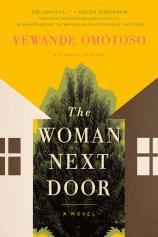The Woman Next Door
Review
The Woman Next Door
One of the great things about reading literature, especially novels and stories from a culture other than your own, is the opportunity simultaneously to learn something new about a time, place, belief system, or way of life you might not share and also to recognize the universal concerns, desires and qualities we all have in common. Set in modern-day South Africa, Yewande Omotoso’s THE WOMAN NEXT DOOR offers exactly this opportunity to readers, in a story about two older women who come to rely on --- if not exactly like --- one another.
"Throughout the novel, the historical legacy and ongoing implications of structural racism are apparent, but Omotoso also touches on issues such as resentment, betrayal, secrecy and shame, all of which give THE WOMAN NEXT DOOR broad emotional resonance beyond its cultural specificity."
Hortensia James and Marion Agostino have been next-door neighbors in their affluent, largely white Cape Town suburb for years. Now both are widows, getting up in years and dealing with different problems that arise as a result of getting older. The two women barely tolerate one another, often butting heads at their regular neighborhood meetings, at which Marion (who is white) frequently accuses Hortensia (who is black, originally from Barbados) of being resentful and overly sensitive when it comes to matters of race and inequality. To Marion’s mind, now that apartheid is a thing of the past, the matter is settled and no longer worth discussing. For Hortensia, small acts of discrimination and thoughtlessness are still a matter of everyday life.
What’s ironic is that on the surface of things, these two ladies have a lot in common. Beyond their age and their neighborhood, both share a professional interest in design; Hortensia is an internationally well-regarded textile designer, while Marion was once an ambitious architect. In fact, Hortensia’s house is the very first one Marion ever designed, a fact that continues to irk Marion, who wishes she could live there rather than in her less well-designed home next door. Omotoso is herself a practicing architect, and her vivid and knowledgeable descriptions of the physical environment and of design are among the most memorable elements of the novel.
Both women are harboring secrets, however, and when circumstances lead them to spend more time together in a shared agreement of convenience, the two might be compelled to begin seeing each other not purely as adversaries but rather as individuals, for the first time.
Told in alternating viewpoints from both Marion’s and Hortensia’s points of view, THE WOMAN NEXT DOOR also shifts between the modern-day events and the two women’s memories of their younger selves, particularly their education and early years of marriage, now long behind them but, in many ways, still shaping their outlooks today. Throughout the novel, the historical legacy and ongoing implications of structural racism are apparent, but Omotoso also touches on issues such as resentment, betrayal, secrecy and shame, all of which give THE WOMAN NEXT DOOR broad emotional resonance beyond its cultural specificity.
Reviewed by Norah Piehl on February 10, 2017
The Woman Next Door
- Publication Date: February 7, 2017
- Genres: Fiction
- Paperback: 288 pages
- Publisher: Picador
- ISBN-10: 1250124573
- ISBN-13: 9781250124579





